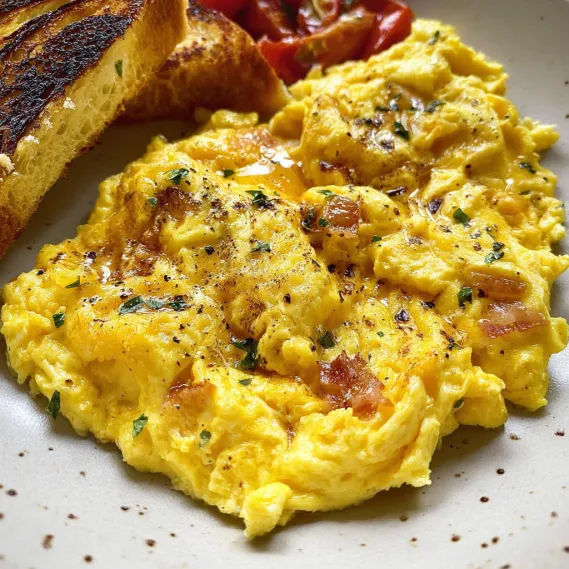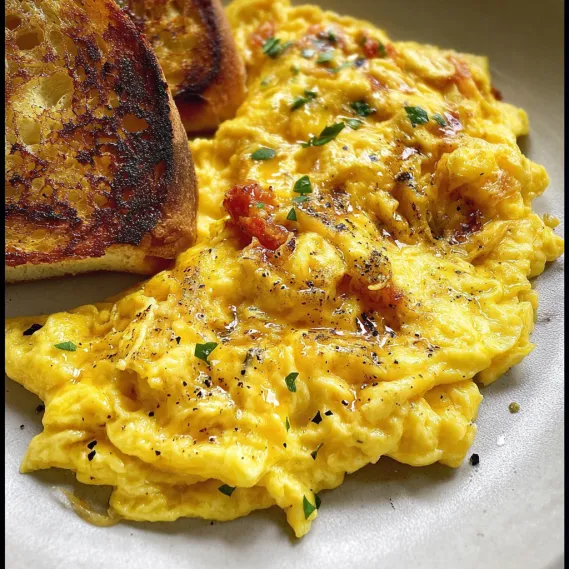 Pin
Pin
Fluffy and creamy scrambled eggs are the quickest comfort food I reach for whenever I need a nourishing start to my day or a last-minute brunch. A good scramble feels like a blank canvas for flavor or makes the simplest meal extra special with almost no effort.
The first time I got the technique of slow cooking and gentle stirring right I could not believe how good eggs could taste. Now it is my reliable go to for solo breakfasts or feeding a crowd.
Ingredients
- Unsalted butter: Adds richness and ensures the eggs will not stick Use real butter for the creamiest texture
- Large eggs: The star You get the most flavor and fluff from fresh pasture raised eggs if you can find them
- Whole milk water or half and half: Adds creaminess and soft curds Whole milk makes them more luxurious while water creates a lighter bounce
- Kosher salt: Brings out the eggs natural flavor Go for flakes or a coarse salt for easier seasoning
- Black pepper: Lends gentle heat and aroma Freshly cracked is best but totally optional
I always check eggs for freshness by placing them in water Fresh ones stay at the bottom
Step-by-Step Instructions
- Melt the Butter:
- Place the unsalted butter in your skillet and set over medium low heat Wait until fully melted but not browned then swirl so the pan is entirely coated This step ensures eggs will not stick and the flavor is fragrant and nutty
- Whisk the Eggs:
- While the butter melts crack the eggs into a bowl Add your milk water or half and half and the salt Use a fork or small whisk to beat vigorously until no streaks of egg white remain Drag the utensil through to catch and dissolve any stubborn bits Uniform blending means soft custardy eggs later
- Cook the Eggs:
- Raise heat to medium and pour eggs into the center of the skillet Take a spatula and gently pull the cooked edges toward the middle in a slow circle letting uncooked egg fill the gaps Stir the middle every few seconds until most of the eggs are softly set and no longer flow to the pan’s edges
- Finish and Serve:
- Continue stirring gently until the eggs are creamy with just the slightest sheen Plate them right away and top with black pepper for a little kick Eggs should be custardy and not dry
 Pin
Pin
My favorite part is the melt of butter as it hits the pan there is something comforting in the already familiar scent It always reminds me of making breakfast for my siblings on lazy weekend mornings and how everyone would gather as soon as eggs hit the plate
Storage Tips
Scrambled eggs are best eaten fresh but you can refrigerate them for up to twenty four hours Store in an airtight container and reheat gently on low to avoid overcooking Microwaving for half a minute with a splash of milk helps maintain moisture If you have leftovers fold them into a breakfast burrito with cheese or veggies
Ingredient Substitutions
Use ghee or olive oil if you want to skip the butter For nondairy try a creamy oat milk or simply use water for the lightest texture Adding a pinch of turmeric gives color or a little grated cheese lends extra richness Chives scallions or even diced tomatoes can make things interesting
Serving Suggestions
Scrambled eggs are delicious on their own but even better with toasted bread and sliced tomatoes Add fresh herbs like parsley or dill for freshness Serve alongside sautéed spinach or avocado for a filling breakfast You can spoon them into breakfast sandwiches or wraps for an easy meal on the go
 Pin
Pin
Cultural Context
Scrambled eggs are treasured worldwide from slow cooked French style to quick fluffy American versions Every family seems to have its own technique and secret ingredient In my house the ritual of slow stirring and patient cooking became a symbol of Sunday mornings and sharing stories before the day begins
Recipe FAQs
- → What is the best pan for cooking scrambled eggs?
A nonstick skillet is ideal, as it prevents sticking and allows for easy stirring and serving.
- → Can I use water instead of milk?
Yes, water will help achieve light eggs, but dairy adds richness and creaminess to the texture.
- → How do I avoid overcooking?
Cook over medium to medium-low heat and remove from the pan while still slightly moist; the eggs will finish setting off the heat.
- → Why beat the eggs thoroughly?
Whisking well ensures yolks and whites are completely blended, giving your eggs a smooth, uniform texture.
- → Is using butter necessary?
Butter lends flavor and helps prevent sticking, but you can substitute with oil if desired.
